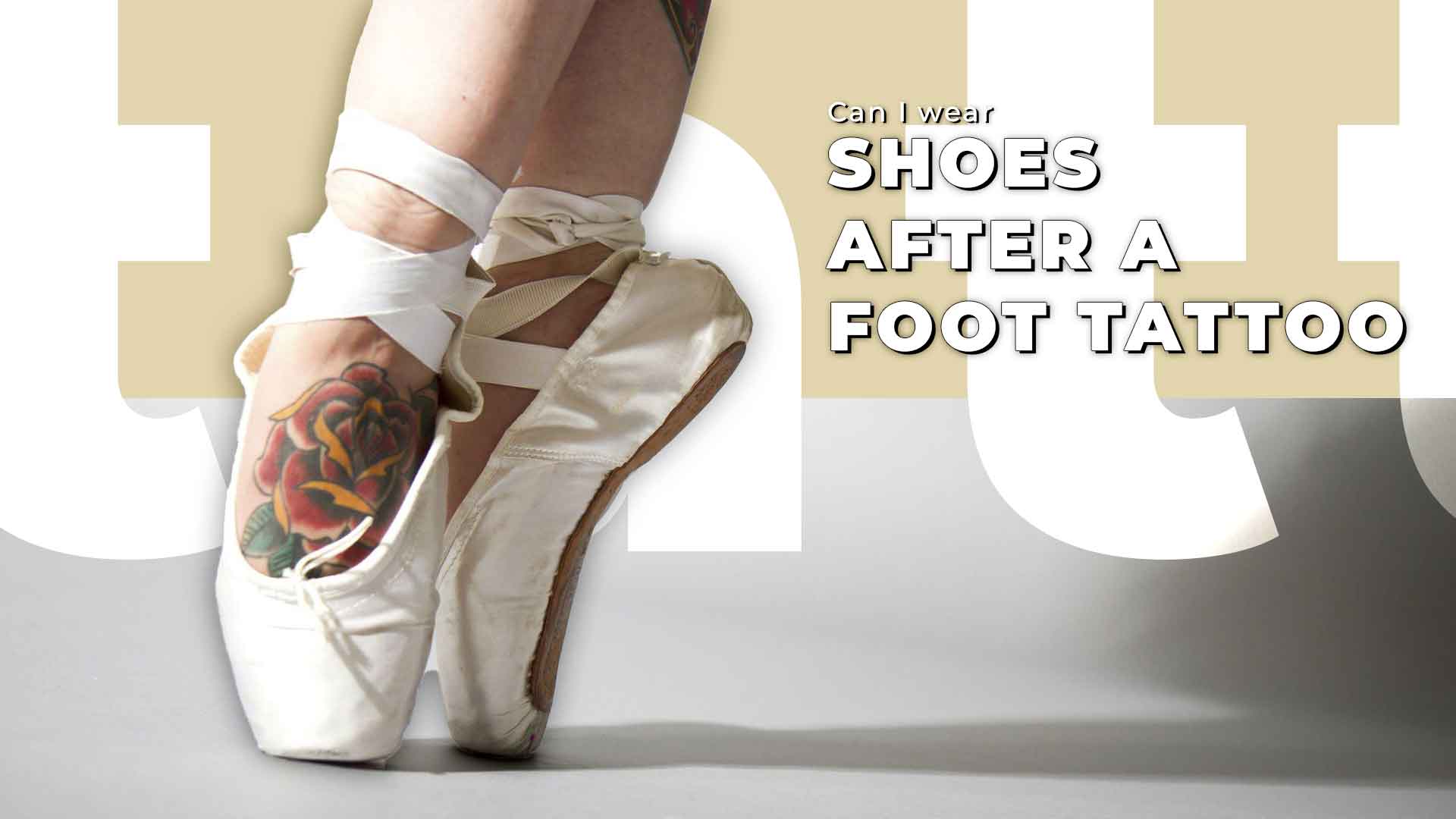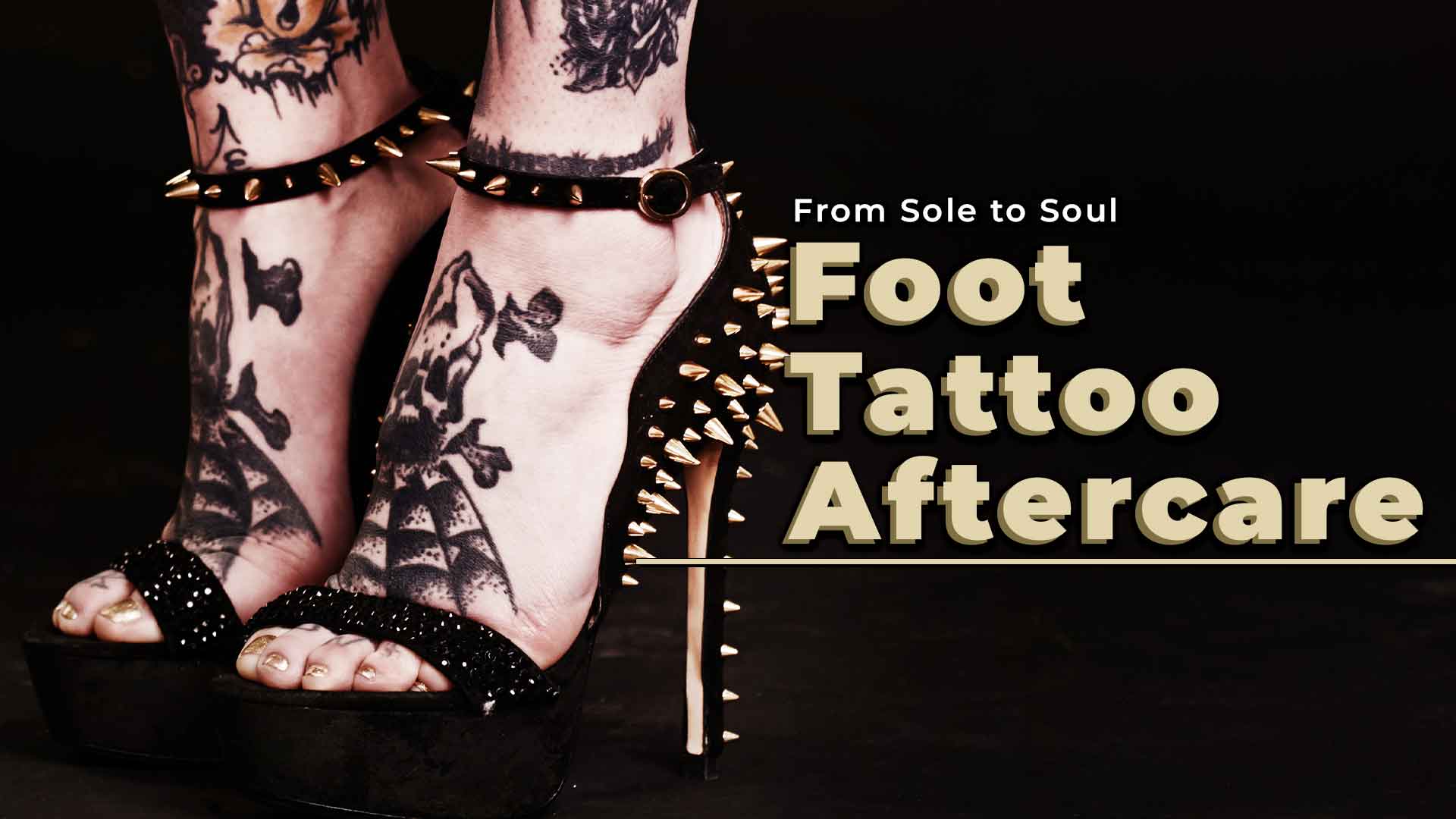Getting a tattoo is an exciting way to express yourself, but proper aftercare is crucial to ensure your tattoo heals correctly and looks great for years. Foot tattoos come with unique challenges, including the rubbing of shoes and socks, exposure to sweat, and potential exposure to bacteria. Avoid tight shoes and socks, soaking the tattoo, scratching or picking, and exposing it to direct sunlight. Following your tattoo artist’s instructions is essential to ensure your foot tattoo heals correctly. After around two weeks, it’s safe to start wearing open-toed shoes.
Tattoos are a form of self-expression that can be an exciting and permanent addition to your body art collection. However, getting a tattoo is only the first step in a process that requires proper aftercare to ensure your tattoo looks its best for years. Getting a tattoo on your foot can be a fun and exciting way to express yourself. Whether a small design or a larger piece, foot tattoos can be a great way to show off your personality and style. However, it’s important to remember that aftercare is crucial for ensuring the tattoo heals properly and looks great for years. Foot tattoos come with unique challenges, including the constant rubbing of shoes and socks, exposure to sweat, and potential exposure to bacteria. In this article, we will provide you with essential aftercare tips and advice to help you keep your foot tattoo looking fresh and vibrant. You can enjoy your new foot tattoo for a lifetime with proper care.
Table of Contents
ToggleHow long does a foot tattoo take to heal?
A foot tattoo can take 2 to 4 weeks to heal fully. During the healing process, keeping the tattoo clean and dry is essential, as avoiding wearing shoes and socks if possible and following any aftercare instructions provided by your tattoo artist.
You may experience redness, swelling, and tenderness around the area in the first few days after getting the tattoo. You may also notice some oozing or scabbing as the tattoo begins to heal. It’s crucial to keep the tattoo clean and apply any ointments or creams recommended by your tattoo artist to prevent infection and promote healing.
As the tattoo starts to heal, you may notice some itching and peeling, a normal part of the process. It’s important not to scratch or pick at the tattoo, as this can damage the skin and cause scarring.
After around two weeks, the tattoo should start to look fully healed, but it’s essential to continue caring for it for another week or two to ensure it’s fully healed. Remember to avoid tight shoes and socks during this time to prevent any irritation or damage to the tattoo.
How do I take care of a Foot Tattoo?

Proper aftercare is essential for a foot tattoo to heal correctly and remain vibrant and beautiful for years. Here are some tips on how to take care of a foot tattoo:
- Keep it clean: One of the most critical aspects of foot tattoo aftercare is cleaning the area. Gently wash the tattooed area with mild soap and water, using your hands instead of a washcloth or loofah to avoid irritation. Rinse the area thoroughly, and pat it dry with a soft towel.
- Apply ointment: After washing the tattoo, apply a thin layer of the recommended lotion or cream to the tattooed area. Your tattoo artist will likely recommend a specific product, such as Aquaphor or A&D ointment. Applying an ointment will help keep the skin moisturized and prevent it from drying out and cracking, which can lead to scarring. Avoid using petroleum-based products or anything that contains alcohol, as these can be too harsh for the tattooed skin.
- Avoid tight shoes and socks: During the healing process, it’s best to wear open-toed shoes or sandals to avoid rubbing or irritation from socks or tight shoes. Tight-fitting shoes can cause the tattoo to rub against the skin, which can cause the ink to fade or even fall out. If you must wear socks, choose a breathable material, such as cotton or bamboo, and change them often to keep the tattooed area dry.
- Avoid soaking: Avoid soaking your foot in the water for at least two weeks after getting a tattoo. This includes swimming pools, hot tubs, and baths. You can take showers but keep the tattooed area out of the water. Water can soften the scabs that form during the healing process.
- Protect from the sun: Avoid exposing the tattoo to direct sunlight for at least two weeks after getting it. After that, use a high-quality sunscreen with a minimum SPF of 30 to protect the tattooed area from fading or damage from the sun. Sun exposure can cause the ink to disappear, especially in the early stages of healing when the skin is still sensitive.
- Don’t scratch or pick: It’s normal for a tattoo to feel itchy during the healing process, but resisting the urge to scratch or pick at the tattooed area is crucial. This can damage the skin and cause scarring or infection. If the itching is unbearable, try applying a cool, damp cloth or hydrocortisone cream to ease the discomfort.
- Follow your tattoo artist’s instructions: Your tattoo artist may have specific aftercare instructions based on the type of ink used or the size and placement of the tattoo. Follow their instructions carefully to ensure that your tattoo heals correctly. They may also recommend a follow-up appointment to check on the healing process and touch up any areas that may have faded during the healing process.
Remember, a foot tattoo is a permanent addition to your body, so taking proper care of it during the healing process is essential to ensure it looks great for years. With proper aftercare, your foot tattoo will heal quickly and beautifully, leaving you with stunning body art to show off.
Can I wear shoes after a foot tattoo?

Foot tattoos require special care during healing, typically taking 2-3 weeks. It’s essential to avoid wearing shoes during this time to prevent the tattoo from getting damaged or infected. Socks and shoes can cause friction, which can irritate the skin and cause the tattoo to blur or fade.
If you must wear shoes, waiting until the tattoo has fully healed is best to avoid complications. Shoes can cause sweating, introducing bacteria to the tattoo and leading to inflammation and infection. Wearing socks can also be problematic as they can stick to the tattoo and cause discomfort.
After around two weeks, it’s safe to start wearing open-toed shoes. However, if you get your tattoo during the winter or colder months, you may need to wait until it’s warmer before you can wear open shoes. It’s crucial to be patient and follow proper aftercare instructions to ensure that your foot tattoo heals correctly and remains a beautiful piece of body art.
To Wear Or Not To Wear- Socks After A Foot Tattoo?
Typically, waiting at least 2-3 weeks after getting a foot tattoo is recommended. Because socks can be tight and snug, they can cause several issues impacting the healing process. When closed, socks can stick to the skin, causing the tattoo to peel off or damage. Additionally, socks can create a moist environment that can increase infection risk and slow the healing process.
Foot tattoos differ from tattoos placed in other areas of the body. With tattoos placed in other areas, keeping the tattoo covered with loose clothing is often recommended. However, wearing loose clothing on the feet is not practical since it would not provide the necessary support and protection that the feet require.
If you must wear socks, choose breathable, clean socks that are not too tight or restrictive. Avoid wearing dirty socks or socks made from synthetic materials that can trap moisture and increase the risk of infection. Changing your socks frequently, especially if your feet tend to sweat, is also a good idea to prevent bacteria buildup and keep the area clean and dry. Opt for open-toed shoes or sandals to allow air circulation and avoid rubbing against the tattooed area.
Should I wrap my tattoo before going to bed?
Wrapping your foot tattoo before going to bed is generally not recommended, especially after the first night. Covering the tattoo can create a moist environment promoting bacterial growth and infection. Additionally, wrapping the tattoo can cause the bandage or wrap to stick to the skin, making it difficult to remove and potentially damaging the tattoo.
After removing the initial bandage, it’s best to allow the tattooed area to breathe and heal naturally. You can wear loose, comfortable clothing to avoid irritation and permit air circulation. Sleeping with your feet uncovered is also recommended to promote air circulation and prevent sweat buildup, which can slow down the healing process and increase the risk of infection.
If you are concerned about your tattoo rubbing against the sheets or bedding, place a clean, soft towel or cloth over the area to protect it while sleeping. However, regularly change the towel or cloth to avoid bacterial growth and promote healing. Overall, it’s best to follow the aftercare instructions provided by your tattoo artist to ensure that your foot tattoo heals appropriately and remains vibrant and beautiful for years to come.
Other Things To Consider About New Foot Tattoos
To ensure proper healing and prevent infection, following certain precautions after getting a foot tattoo is essential. Working out and wearing tight shoes should be avoided as they can cause irritation and sweating. Pedicures should also be postponed for at least 2-3 weeks as soaking the tattooed area can prolong healing and increase the risk of infection. Additionally, foot tattoos are prone to fading due to constant friction and exposure to the elements.
Getting a foot tattoo during winter may be inconvenient as it requires avoiding socks and shoes. Cleaning the tattoo with lukewarm water and mild, fragrance-free soap is recommended. It is crucial to avoid submerging the tattoo in water for extended periods and to keep showers short.
Getting one foot tattooed at a time is advisable, as getting both can cause discomfort and difficulty in walking. Ink migration is a potential issue for foot and ankle tattoos, so placement should be carefully considered. Individuals with circulation issues or diabetes should avoid getting tattoos on their feet.
After getting a foot tattoo, it is essential to elevate the feet to reduce swelling and avoid swimming or soaking in pools, as they may contain bacteria that can lead to infection. By following these aftercare tips, the healing process can be smoother, minimizing the risk of complications.
The Final Thought

Getting a foot tattoo can be a beautiful and meaningful way to express yourself, but it requires careful consideration and proper aftercare to ensure a successful healing process. By avoiding certain activities, keeping the tattoo clean and dry, and being mindful of potential complications, you can enjoy your foot tattoo for years. Remember to consult with a professional tattoo artist and follow their specific aftercare instructions to ensure the best possible outcome.

